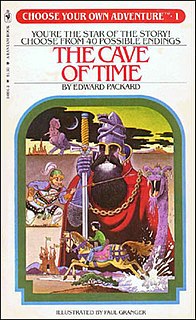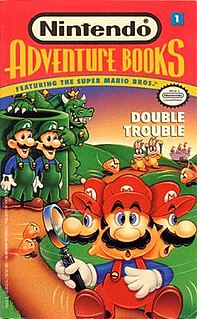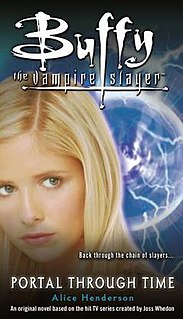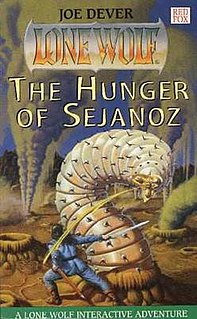
Fighting Fantasy is a series of single-player role-playing gamebooks created by Steve Jackson and Ian Livingstone. The first volume in the series was published in paperback by Puffin in 1982.

Choose Your Own Adventure, or Secret Path Books is a series of children's gamebooks where each story is written from a second-person point of view, with the reader assuming the role of the protagonist and making choices that determine the main character's actions and the plot's outcome. The series was based upon a concept created by Edward Packard and originally published by Constance Cappel's and R. A. Montgomery's Vermont Crossroads Press as the "Adventures of You" series, starting with Packard's Sugarcane Island in 1976.
Hypertext fiction is a genre of electronic literature, characterized by the use of hypertext links that provide a new context for non-linearity in literature and reader interaction. The reader typically chooses links to move from one node of text to the next, and in this fashion arranges a story from a deeper pool of potential stories. Its spirit can also be seen in interactive fiction.
A gamebook is a work of printed fiction that allows the reader to participate in the story by making choices. The narrative branches along various paths, typically through the use of numbered paragraphs or pages. Each narrative typically does not follow paragraphs in a linear or ordered fashion. Gamebooks are sometimes called choose your own adventure books or CYOA after the influential Choose Your Own Adventure series originally published by US company Bantam Books. Gamebooks influenced hypertext fiction.
Time Machine is a series of children's novels published in the United States by Bantam Books from 1984 to 1989, similar to their more successful Choose Your Own Adventure line of "interactive" novels. Each book was written in the second person, with the reader choosing how the story should progress. They were designed by Byron Preiss Visual Publications.

Give Yourself Goosebumps is a children's horror fiction gamebook series by R. L. Stine. After the success of the regular Goosebumps books, Scholastic Press decided to create this spin-off series in 1995. In fact, Stine had written gamebooks in previous years.

Nintendo gamebooks are novels based on video games created by Nintendo. The gamebooks feature characters and settings from the Super Mario and The Legend of Zelda franchises, in two series, Nintendo Adventure Books and You Decide on the Adventure.

The Endless Quest books were three series of gamebooks. The first one was released in the 1980s by TSR, while the following two were released by Wizards of the Coast. Originally, these books were the result of an Educational department established by TSR within the intention of developing curriculum programs for subjects such as reading, math, history, and problem solving.

Legend of Zagor is a single-player roleplaying gamebook written by Carl Sargent, although it is credited to Ian Livingstone, illustrated by Martin McKenna and originally published in 1993 by Puffin Books. It was later republished by Wizard Books in 2004. It forms part of Steve Jackson and Ian Livingstone's Fighting Fantasy series. It is the 54th in the series in the original Puffin series (ISBN 0-14-036566-4) and 20th in the modern Wizard series (ISBN 1-84046-551-4).

Keep Me In Mind is an original game-novel based on the U.S. television series Buffy the Vampire Slayer. This is the second in the line of Buffy books called Stake Your Destiny, modeled after the popular Choose Your Own Adventure series in which the reader decides the fate of the characters. There are more than a dozen possible endings.

The Suicide King is a novel by Robert Joseph Levy. It is based on the American television series Buffy the Vampire Slayer. The first in the line of Buffy "Stake your Own Destiny" books, Suicide King gives the reader a large series of choices. Once a choice is made, the page number to turn to is given. The result is that the reader might decide the fate of the characters.
Colin Brake is an English television writer and script editor best known for his work for the BBC on programmes such as Bugs and EastEnders. He has also written spin-offs from the BBC series Doctor Who. He lives and works in Leicester.

Colony is an original novel based on the U.S. television series Buffy the Vampire Slayer. This novel is part of the line of Buffy books called "Stake your Own Destiny". These books give the reader a large series of choices, once a choice is made, the page number to turn to is given. The result is that the reader might decide the fate of the characters. With this novel, there are more than a dozen possible endings.

Portal Through Time is an original novel based on the U.S. television series Buffy the Vampire Slayer. It was published in 2006. The author, Alice Henderson, also wrote, Night Terrors in the Stake Your Destiny series. In this novel, Buffy and her friends time-travel to four different periods of history to protect Slayers of the past from present-day vampires.

The Hunger of Sejanoz is a gamebook by Joe Dever. It is the twenty-eighth book of the award-winning Lone Wolf book series. It was the last book to be released in the New Order series for the next eighteen years as the 29th book of the series, The Storms of Chai, was published in 2016.
Dragontales was a series of gamebooks written by Rhondi A. Vilott Salsitz as "Rhondi Vilott" and published by Signet in the 1980s. The books place the reader in the role of a young man or woman in various fantasy countries inhabited by a variety of extravagant creatures. The books were meant for readers somewhat older than those of most game books, as romance is a common element, as are allusions to physical development in the books' heroines.

Be An Interplanetary Spy is a series of twelve interactive children's science fiction books designed by Byron Preiss Visual Publications and first published by Bantam Books from 1983 to 1985.
The interactive novel is a form of interactive web fiction. In an interactive novel, the reader chooses where to go next in the novel by clicking on a piece of hyperlinked text, such as a page number, a character, or a direction. While authors of traditional paper-and-ink novels have sometimes tried to give readers the random directionality offered by hypertexting, this approach was not completely feasible until the development of HTML. For a discussion of paper novels that use a branching structure, such as Choose Your Own Adventure novels, see the gamebook article. For video games that use a branching structure, see the visual novel article.